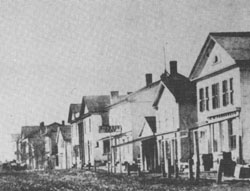Hudson Historic District (Ohio) facts for kids
Quick facts for kids |
|
|
Hudson Historic District
|
|

Historic view of Hudson from the late 1880s
|
|
| Location | Roughly bounded by College, Streetsboro, S. Main, and Baldwin Streets Hudson, Ohio |
|---|---|
| Area | 70 acres (28 ha) |
| Built | 1806 |
| Architect | Lemuel Porter Et al. |
| Architectural style | Greek Revival, Federal |
| NRHP reference No. | 73001542 |
| Added to NRHP | November 28, 1973 |
The Hudson Historic District is a special area in Hudson, Ohio, known for its old and important buildings. It was added to the National Register of Historic Places in 1973. This means it's recognized as a place with a lot of history that should be protected.
Contents
Exploring Hudson's Rich History
Hudson, Ohio, has a fascinating past. Many of its old buildings and streets still show what life was like long ago.
How Hudson Began
The town of Hudson was started in 1802. It was named after its founder, David Hudson. He led a group of settlers from Goshen, Connecticut, to this new land. This area was once part of Connecticut's "Western Reserve." Even after Connecticut gave up its claims to western lands, it kept this part of northeastern Ohio. Hudson still feels a lot like a New England town today. It has a central town green, just like many old towns in New England.
Early Growth and Famous Buildings
Hudson started to grow when the Ohio and Erie Canal opened nearby in Peninsula. The canal brought more trade and businesses to the area. In 1826, the Western Reserve College was founded in Hudson. It became known as "the Yale of the West" because it was such a respected school.
Today, this college is a private school called Western Reserve Academy. It built one of the first observatories in North America in 1838. Two important builders, Lemuel Porter and his son Simeon, worked a lot in Hudson in the early 1800s. Many of their buildings have a special detail: a "wheat fanlight" design above the door. This design looks like cut wheat held in the middle, with ends dropping down. You can see it on the Bliss House (built in 1831), which faces the town green. The Brewster Mansion, built in 1853, is another unique building near the green. It has an unusual Moorish style.
Challenges and a New Beginning
After the American Civil War, Hudson continued to grow thanks to the railroads. However, some people in Hudson lost a lot of money by investing too much in the railroads. In 1882, the college moved to Cleveland. Then, in 1892, a big fire destroyed much of Hudson's downtown area.
But Hudson found a way to recover! A man named James W. Ellsworth, who grew up in Hudson, returned to town. He had made a lot of money in the coal business. Ellsworth decided to make Hudson a "model town." He planted trees, brought electricity, paved streets, and set up water and sewer systems. In 1912, he even built the clock tower on the town green. Thanks to his efforts, Hudson has been a successful town ever since.



